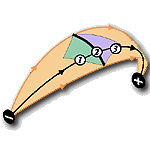
|
Computing Visibility for Triangulated Panoramas
Chi-Wing Fu
,
Tien-Tsin Wong
and
Pheng-Ann Heng
,
|
Abstract
-
- A visibility algorithm for triangulated panoramas is proposed. The algorithm can correctly resolve the visibility without making use of any depth information. It is especially useful when depth information is not available, such as in the case of real-world photographs. Based on the optical flow information and the image intensity, the panorama is subdivided into variable-sized triangles, image warping is then efficiently applied on these triangles using existing graphics hardware. The visibility problem is resolved by drawing the warped triangles in a specific order. This drawing order is derived from epipolar geometry. Using this partial drawing order, a graph can be built and topological sorting is applied on the graph to obtain the complete drawing order of all triangles. We will show that the time complexity of graph construction and topological sorting are both linear to the total number of triangles.
- A visibility algorithm for triangulated panoramas is proposed. The algorithm can correctly resolve the visibility without making use of any depth information. It is especially useful when depth information is not available, such as in the case of real-world photographs. Based on the optical flow information and the image intensity, the panorama is subdivided into variable-sized triangles, image warping is then efficiently applied on these triangles using existing graphics hardware. The visibility problem is resolved by drawing the warped triangles in a specific order. This drawing order is derived from epipolar geometry. Using this partial drawing order, a graph can be built and topological sorting is applied on the graph to obtain the complete drawing order of all triangles. We will show that the time complexity of graph construction and topological sorting are both linear to the total number of triangles.
Download Paper
- Acrobat: panowalk.pdf (4.29 MB)
Blending of Two Warped Panoramas
Animation
The following animations demonstrate the warping and blending result of combining two panoramas. Both animations are in QuickTime movie format.|
Attic (4Mb) |
| |
|
City (6Mb) |
|
Related Publications
- "
Triangle-based View Interpolation Without Depth Buffering",
C. W. Fu, T. T. Wong and P. A. Heng,
Journal of Graphics Tools, Vol. 3, No. 4, 1998, pp. 13-31. - "
Binary-Space-Partitioned Images for Resolving Image-based Visibility",
C. W. Fu, T. T. Wong, W. S. Tong, C. K. Tang and A. J. Hanson,
IEEE Transactions on Visualization and Computer Graphics, Vol. 10, No. 1, January-February 2004, pp. 58-71.






